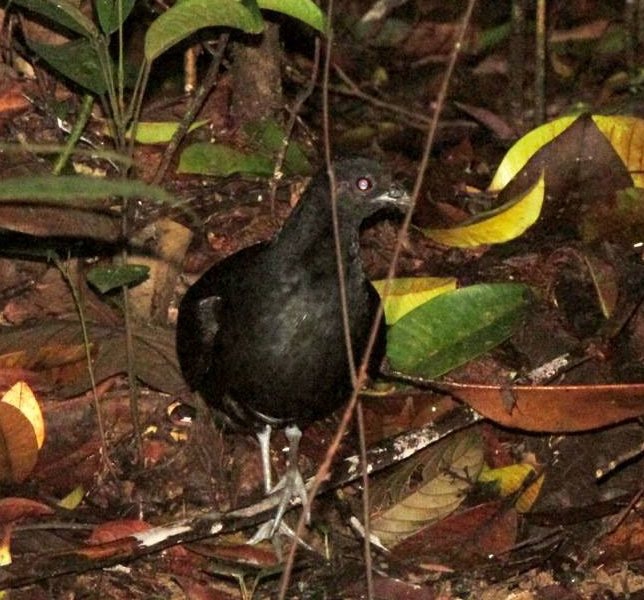| Citation |
|
Description |
Geographic Range [top]
Range Description: Melanoperdix niger is known from Peninsular and East Malaysia (including both Sabah and Sarawak), and Kalimantan and south Sumatra, Indonesia. It is described as local and sparse to uncommon in Peninsular Malaysia, and there are recent records from at least three sites in Kalimantan and one in Sumatra. It seems scarce and patchy in distribution, although it is easily overlooked owing to a previous lack of information on vocalisations and its elusive behaviour (B. van Balen in litt. 2012). As a result, its distribution and population status are generally very poorly known across its entire range. It is presumably declining because of rapid on-going reductions in its habitat.
Countries occurrence:
Native:
Brunei Darussalam; Indonesia; Malaysia
Regionally extinct:
Singapore
Additional data:
? Continuing decline in area of occupancy (AOO): Yes
? Extreme fluctuations in area of occupancy (AOO): No ? Estimated extent of occurrence (EOO) - km2: 2840000
? Continuing decline in extent of occurrence (EOO): Unknown ? Extreme fluctuations in extent of occurrence (EOO): No
? Number of Locations: 11-100 ? Continuing decline in number of locations: Yes
? Extreme fluctuations in the number of locations: No
? Upper elevation limit (metres): 1200
Range Map: Click here to open the map viewer and explore range.
Population [top]
Population: The population size is preliminarily estimated to fall into the band 10,000-19,999 mature individuals. This equates to 15,000-29,999 individuals in total, rounded here to 15,000-30,000 individuals.
Trend Justification: Rates of forest loss in the Sundaic lowlands have been extremely rapid (Kalimantan lost nearly 25% of its evergreen forest during 1985-1997, and Sumatra lost almost 30% of its 1985 cover, exacerbated by forest fires in 1997-1998). This rate of deforestation is suspected to have driven a rapid population decline in this species, which is probably continuing.
Current Population Trend: Decreasing
Additional data:
? Number of mature individuals: 10000-19999 ? Continuing decline of mature individuals: Yes
? Extreme fluctuations: No ? Population severely fragmented: No
? No. of subpopulations: 2-100 ? Continuing decline in subpopulations: Yes
? Extreme fluctuations in subpopulations: No ? All individuals in one subpopulation: No
? No. of individuals in largest subpopulation: 1-89
Habitat and Ecology [top]
Habitat and Ecology: In Peninsular Malaysia, it is judged to be a lowland specialist, where it has a proclivity for primary or mature, regenerated, closed-canopy evergreen forest on alluvial soils. In Indonesia, it has been recorded in peatswamp forest, and historically was described as inhabiting brushwood and high bamboo-jungle. Recent evidence from Borneo suggests that it probably extends up to at least 900 m, perhaps 1,200 m.
Systems: Terrestrial
Continuing decline in area, extent and/or quality of habitat: Yes
Generation Length (years): 3.9
Movement patterns: Not a Migrant
Threats [top]
Major Threat(s): The overriding threats are habitat loss, degradation and fragmentation as a result of large-scale commercial logging, which targets all remaining stands of valuable timber, even within protected areas, and the widespread clearance for plantations of rubber and oil-palm. Rates of forest loss in the Sundaic lowlands have been extremely rapid (Kalimantan lost nearly 25% of its evergreen forest during 1985-1997, and Sumatra lost almost 30% of its 1985 cover). Furthermore, the full impact of the major fires of 1997-1998 has still to be fully assessed, but drought fires appear to be increasing in frequency and severity on Sumatra and Borneo. Hunting for food may pose an additional, more localised, threat.
Conservation Actions [top]
Conservation Actions: Conservation Actions Underway
It is known to occur in at least six protected areas: Taman Negara and Krau Wildlife Reserve (Peninsular Malaysia), Kinabalu National Park (Sabah), Gunung Mulu National Park (Sarawak), Tanjung Puting National Park and Gunung Palung Nature Reserve (Kalimantan), and Berbak Game Reserve (Sumatra). It also occurs in Pasoh Reserve Forest in Peninsular Malaysia.
Conservation Actions Proposed
Afford the species full protection under Indonesian and Malaysian law. Conduct research into its ecology and habitat requirements. Identify and record its vocalisations to aid field surveys. Identify remaining suitable habitat tracts, and conduct extensive field surveys and village interviews within these areas to clarify its current distribution and population status. Following surveys, review whether key populations are adequately represented within the existing protected areas network, and advocate protection of further areas if necessary. Develop support mechanisms for key Important Bird Areas (IBAs) in Peninsular Malaysia.
Citation: BirdLife International. 2016. Melanoperdix niger. The IUCN Red List of Threatened Species 2016: e.T22678934A92794900. http://dx.doi.org/10.2305/IUCN.UK.2016-3.RLTS.T22678934A92794900.en. Downloaded on 17 May 2017.
Disclaimer: To make use of this information, please check the .
Feedback: If you see any errors or have any questions or suggestions on what is shown on this page, please provide us with feedback so that we can correct or extend the information provided
|

